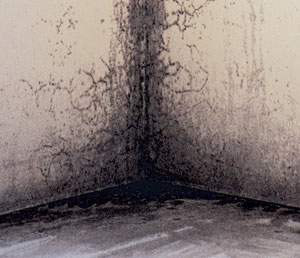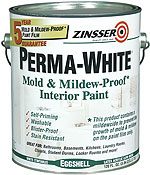
Put up Some Resistance!
Paints that control mold and mildew growth can be great assets in the kitchen and bath.
by Stacey Enesey Klemenc
that discourage the growth of mold and mildew on the paint film. The Sherwin-Williams Co. has Duration Home and Harmony. Benjamin Moore advertises Regal Matte. Zinsser brags about its Perma-White. Pratt & Lambert touts Accolade. California Paints boasts about its top-of-the-line 2010 super-scrubbable ceramic paint. And the list goes on.
Thanks in large part to pressure applied by widespread media hype, today’s premium products — whether they’re made for the interior or exterior — contain some degree of mildewcide that companies promise will keep the paint film mold- and mildew-free for a certain amount of time, which is typically for the life of the coating. They are washable and/or scrubbable. And they protect against an unknown number of fungi invaders.
But, experts agree, in order for them to work there’s one thing that must be done first.
“You need to take care of mildew at its source before you paint,” says Andy Rzicznek, product manager with Pratt & Lambert. “I don’t know of any paint that kills mildew and mold spores.”
And if there were such an animal, it would have to be registered with the Environmental Protection Agency as a pesticide.
Proper preparation. That’s the key to successfully keeping mold and mildew from invading a freshly painted surface, stresses Jeff Spillane, senior marketing manager for Benjamin Moore.
“One of the biggest mistakes painters make is power-washing a house and thinking that just because they don’t see any mildew that it’s been blown away. It’s like mowing a lawn that’s filled with dandelions. When the grass is first cut, it looks great. But a week later, all the dandelions are back,” he says.
“The key to a successful paint job is to prepare the surface and remove and kill the mildew. You need to coat the surface with bleach and then power wash or scrub it off. If you paint a house with mildew spores present, you’ll embed the spores into the film and the mildew will be hard to get rid of, if not impossible,” Spillane says.
Many industry experts agree that a 3:1 mixture of water and bleach will kill existing mildew. However, recent Sherwin-Williams literature claims bleach can control mold growth on surfaces but often doesn’t affect the source of the problem. It goes on to say that bleach shouldn’t be used on porous materials or metal.
As a general rule, painting manufacturers don’t recommend adding mildewcides to their paint.
“We formulate our anti-microbial coatings with all the necessary ingredients required for performance,” sums up Steve Revnew, director of marketing for The Sherwin-Williams Co.’s residential segments. “Adding ingredients could impact the coating’s performance, diminish its washability, affect its color and ultimately alter the stability of the coating. Extra ingredients can change the whole chemistry of a product.”
“It’s no different than thinning,” Spillane says. “The development and manufacturing of a coating is complex and it is generally recommended that products not be altered.”
While a mildewcide additive may help with lower-quality products, says Dave Thompson, director of technical services and professional sales for California Paints, many of the premium exterior products on the market today already contain the highest level of mildewcides approved by the EPA. And adding more to an interior product, which has a lower approved amount, may not comply with the law. It also may be harmful to your clients’ health.
 Still, maintains Frank Glowacki, senior business manager for Zinsser, mildewcide additives do have their place. His company, for instance, markets a product called ADD-2, an EPA-registered fungicide designed to prevent mold and mildew on coating film. “Post-mildewcide products will give you adequate protection,” he says. “For short-term protection, ours is very good. But none are designed to protect long term and guarantee protection. You can’t just take a can of paint that hasn’t been designed from the ground up and add something and get the same results.” Still, maintains Frank Glowacki, senior business manager for Zinsser, mildewcide additives do have their place. His company, for instance, markets a product called ADD-2, an EPA-registered fungicide designed to prevent mold and mildew on coating film. “Post-mildewcide products will give you adequate protection,” he says. “For short-term protection, ours is very good. But none are designed to protect long term and guarantee protection. You can’t just take a can of paint that hasn’t been designed from the ground up and add something and get the same results.”
“There are mildewcides you can add to your paint,” agrees Rzicznek. “However, you need to check with the manufacturer because adding things to the paint may void the warranty.”
Many will say if you start messing with what’s in the can, you’re on your own.
Because of the nature of the beast, most mold- and mildew-resistant paints are water-based. “Alkyd-based products are excellent food sources for mold and mildew,” Revnew says, and are much more attractive to the fungi than latex-based products.
In order for mold or mildew to grow, he continues, there must be three things present, all of which are readily available in a home, particularly in a kitchen or bath. “Moisture, that’s the biggest one. Mold also needs a food source and the right temperature, somewhere between 60 and 100 degrees Fahrenheit.”
In today’s formulated paint, Revnew continues, an anti-microbial product, which must be registered with the EPA and meet all of its regulations, inhibits growth of mold or mildew on the paint film.
“Coatings are controlled by VOC regulations which can limit the types and amount of ingredients used to produce the product,” Spillane says.
“Our top-of-the-line exterior products have the maximum amount of fungicide and mildewcide allowed by the EPA,” says Thompson. “For the interior, we have four product lines that have something in them called Microban, which is used in many Rubbermaid products, toothbrushes, cutting boards, air filters and even caulking compounds.” This anti-bacterial compound not only fights germs, it’s also effective against mold and mildew.
Simply put, Thompson explains, Microban is an intrinsic part of the paint. When mold and mildew come in contact with the surface, Microban penetrates the cell wall of the microbe and disrupts key cell functions. It cannot function, grow or reproduce. “A lot of paint manufacturers use mildewcides that are formaldehyde donors to kill the organisms,” he says. “But Microban works totally different.”
In the early ‘90s, Zinsser formulated a paint with a unique proprietary resin system combined with a special mildewcide package that prevents the growth of mold and mildew on the paint film. “This unique formula allows moisture to pass through the paint film to prevent cracking and peeling,” says Angela Cunningham, brand manager for mold and mildew preventative products for Zinsser. “It’s very breathable,” she says about the company’s self-priming Perma-White products.
“Because of this formula, we’re able to back Perma-White with a five-year mold- and mildew-proof paint film guarantee,” she continues. “Many paints are formulated for mildew resistance. Perma-White is formulated to be mold- and mildew-proof. There is a difference.”
Zinsser’s Glowacki points out that there are a few coatings on the market that are EPA-registered to prevent the growth of mold and mildew. “If you have an EPA-registered product, it must be white or clear. By law, you’re not allowed to add color to it,” he explains. Unlike Perma-White, these products are meant to deliver protection and not be seen. Perma-White, on the other hand, is also designed to look beautiful.
“Perma-White uses EPA-registered mildewcides but it is not an EPA-registered product,” he says, adding that his company’s claims are fully EPA-compliant.
All Perma-White products are tintable up to a mid-tone color, Glowacki says. “Colorant is a food source for mold growth so we limit it to four ounces [per can]. Why take the chance with darker colors?”
Many other paint manufacturers disagree with this line of thinking and offer their mold- and mildew-resistant products in a wide range of deep tones.
The higher the sheen, Rzicznek points out, the tighter the paint film and the lower the chance of mildew growth. “Flat paints have a higher chance of seeing mildew,” he observes. “They are very porous and there are more places for moisture and dirt to settle, which is a perfect environment for mildew.”
Perhaps that’s why some companies do not offer their mold-resistant products with a flat finish. The most popular offerings include semigloss and eggshell.
Regardless of the sheen or the quality of the product, Spillane maintains if the conditions are right mold and mildew will eventually grow. “At a certain point, mildew can grow on anything. In the laboratory, scientists can even get it to grow on glass. You can slow it down, but if it’s in a bad enough environment I don’t think there’s anything that will totally stop it.”

|

